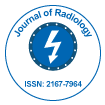Common Imaging Features of Covid-19
Received: 12-Jun-2020 / Accepted Date: 23-Jul-2020 / Published Date: 31-Jul-2020 DOI: 10.4172/2167-7964.1000324
Abstract
Corona virus disease-19 (Covid-19) is an infectious disease which has spread globally since its discovery in China. A combination of chest radiography (CXR) and chest computed tomography (CT) were initially used in imaging technology to identify covid-19, the viral etiology of covid-19. Early diagnosis, quarantine and supportive treatments are essential to cure patients. The aim of this review article is to provide information about common and basic imaging features of covid-19 patient.
Introduction
On March 11, 2020 WHO declared coronavirus disease-19 (covid-19) a pandemic because of rapidly increasing cases in the world. It was named SARS-CoV-2 (severe acute respiratory syn-drome corona virus 2) by the International Committee on Taxonomy of Viruses (ICTV) [1]. But recently it is referred to as “coronavirus disease 2019” (covid-19) by World Health Organization (WHO). It started from Wuhan in central China and spread worldwide [2,3]. Covid-19 has proven to be extremely contagious and easily transmits from person to person [4]. It affects the lower respiratory tract and causes severe pneumonia. But the most common manifestations of covid-19 are fever, fatigue, and dry cough. Other symptoms of covid-19 are myalgia, chest tight-ness, nausea, vomiting, dyspnea, and diarrhea [4]. For the diagnosis of covid-19 radiology department is playing an important role. The first diagnostic tool was RT-PCR [5]. But due to the limited supply of RT-PCR kits, some experts started using chest computed tomography (CT) rather than RT-PCR [6]. RT-PCR reported sensitivity ranges from 60–70%, the sensitivity of CT was 97%. RTPCR showed many negative results for covid-19 but later they were positive in CT [7,8]. Chest computed tomography (CT) is a main diagnostic tool for the detection of covid-19. CT scan shows images of typical viral pneumonia with multiple bilateral ground-glass opacities in positive covid-19 patients [4]. This review aims to briefly introduce the value of imaging in covid-19 diagnosis.
Current diagnostic symptoms for covid-19
Symptoms in detecting covid-19 patients are not specific. It is reported that 44% of 1099 covid-19 patients had fever when they entered in hospital but 89% developed a fever while in hospital [9]. They further found that patients had a cough (68%), fatigue (38%), sputum production (34%), and shortness of breath (19%). Many of these symptoms are associated with respiratory infections. CT scans have been used for diagnosing covid-19. CT and RT-PCR are sensitive tests in diagnosing covid-19.
CHEST radiographic characteristics of covid-19
Chest radiograph is not preferable for the diagnosis of the covid-19 patients because of its insensitivity. It is unable to early diagnose the covid-19 [10]. But in severe condition, radiograph shows some typical characteristics [11]. Consolidation was the most common finding, followed by GGO. Peripheral and lower zone distribution were the most common sites of ground glass opacities (GGO) [10]. Some severe cases show whited out lungs on radiograph [12].
CT of pediatric patients
There are many differences between the radiological findings of adults and pediatric patients. CT manifestations of adult patients with covid-19 were reported to be remarkably diverse. In adults there are GGO with consolidation, interlobular septal thickening, bronchial wall thickening, and crazy paving pattern [4]. But in pediatric patients only ground glass opacities are present. Up to 44% adult patients had all 5 lobes affected [13]. But in pediatric condition mostly patients had only 1 lobe affected [14]. But there is a little known about the pediatric patients. The large sample studies are needed in the future
CT imaging characteristics of covid-19 in adults
In the time of emergency chest computed tomography (CT) is playing an important in the detection of covid-19. Chest CT is performed and taking many X-ray measurements across different angles which are analyzed by radiologists to look for abnormal features which may led to diagnosis. Chest computed tomography (CT) is recommended because it is overly sensitive in detecting early disease. It gives 97% sensitive results [15,16]. Typical chest CT imaging characteristics of covid-19 include multiple, peripheral, patchy, subsegmental, or segmental ground glass opacities and areas of consolidation, which, mostly distributed along the peripheral region[4,17].There are some cases in which pneumonic-mediastinum and sub-cutaneous emphysema were also observed. When most of the lungs are infected, the lungs appears as a “whited out lung”. In severity of a disease patient die with covid-19 [19]. After isolation and treatment majority of patients recovered with covid-19.
Conclusion
The covid-19 pandemic is a public health emergency. All countries need a coordinated effort to fight with covid-19. In the absence of vaccines, quarantine and isolation are achieving remarkable results.
But at this time of emergency, imaging technology is playing an unforgettable role in diagnosing covid-19. But still we know little about this virus. So, we must find other ways to diagnose this virus.
References
- Li Q (2020) Early Transmission Dynamics in Wuhan, China, of Novel Coronavirus-Infected Pneumonia.
- Guan WJ (2020) Clinical Characteristics of Coronavirus Disease 2019 in China. N Engl J Med 382:1708-1720.
- Yang W (2020) The role of imaging in 2019 novel coronavirus pneumonia (COVID-19). European Radiology.
Citation: Ashraf N (2020) Common Imaging Features of Covid-19. OMICS J Radiol 9: 1000324. DOI: 10.4172/2167-7964.1000324
Copyright: © 2020 Ashraf N. This is an open-access article distributed under the terms of the Creative Commons Attribution License, which permits unrestricted use, distribution, and reproduction in any medium, provided the original author and source are credited.
Share This Article
Open 91桃色 Journals
Article Tools
Article Usage
- Total views: 2098
- [From(publication date): 0-2020 - Apr 23, 2025]
- Breakdown by view type
- HTML page views: 1354
- PDF downloads: 744
